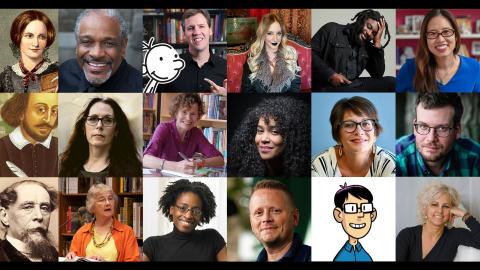Choosing an author is a crucial task in setting up an author study and there are many facets to consider. Here are some key points to think about:
Do you want to choose one author for the entire class to study?
Or do you want to create student groups (perhaps based on reading ability) and have each group study a different author?
Will you choose the author(s) to be studied, or will you give students a voice in the matter?
Including students in the selection process can be a good way to engage them, but students may be less likely to choose unfamiliar authors if they choose for themselves.
How old are your students?
If they are in early elementary school, then a picture book author might be best. A picture book author can also be a good choice for older students who are interested in illustration or if you, as the teacher, are interested in boosting your students’ visual literacy or prompting student’s own writing. A related point: a study of a picture book author also might work well for reluctant or struggling readers; there are some picture book authors, such as Patricia Polacco, who tackle mature themes using the picture book format. Authors like Jacqueline Woodson, Kevin Henkes, and Karen Hesse who write across genres and reading levels, are good choice for author studies.
Create an Author Study Center in your classroom
Choose a corner, or other place where you can keep and display books for the author study. Or you can ask students where they think the author study center should be located. If you’re doing a classroom-wide author study, take a tri-fold display board and decorate it with the author’s name and photo.
Then students can add more information and more photos as they research the author. If students are doing different authors, you can use a tri-fold display board as a photo gallery of the authors. If you can have a computer in the center, students can create online multimedia display, including websites, Facebook pages, etc.
Make sure you have enough room in your center to later display work created by students as part of their author study.
Is there a special event or author visit that can coincide with your author study?
Many teachers develop author studies in conjunction with special literacy events like Poetry Month or Teen Read Week, or with visits that authors may be making to their communities. Check the literacy calendar at ReadingRockets.org for upcoming celebrations and consult your local library and reading councils for information on author visits.
What are your students’ interests?
Doing a survey of your students might be a good way to determine their interests. Depending on the survey results, you might either want to follow those interests or work to expand your students’ horizons (i.e. by suggesting that they focus on non-fiction if they only read fiction, etc.). You also can ask students about authors they love and why and create a list of possibilities from those recommendations.
What genre will work best for your students and/or for your own goals for the author study?
If your students seem particularly interested in non-fiction or if you think a bit of non-fiction could stretch their reading interests-that’s an obvious choice. If you’re hoping to show readers the magic of creating characters, then realistic fiction might be best; if your students enjoy have vivid imaginations, fantasy could fit the bill. Keep in mind your purpose for the author study as you make your choices.
Two practical considerations
If you’re doing a classroom author study, you’ll need to either be able to read an author’s books aloud to all students or have enough copies for each student. To round up enough copies, you might borrow books from the school and public library, ask parents to donate any copies they have (or give money to purchase some), ask the PTA for a grant or ask local bookstores or even publishers to donate copies.
Most children’s book authors now have websites and other information about them may also be available online and in print. Before settling on a particular author, it’s a good idea to research — or ask the librarian to research — what information is available about particular authors. Authors whose books have become movies are interesting author study candidates, giving students an opportunity to compare a screen adaption with an original text.
Create a list of authors to give students a possible starting point
Check the lists of the Caldecott and Newbery medal and honor winners. Reading Rockets and AdLit offer a treasure trove of information about possible authors to study. Other websites to check for authors include:
- TeachingBooks.net
- Diverse Authors and Illustrators for Young Readers (created by Nikki Grimes)
- Scholastic Author Studies
